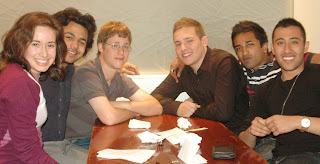 |
| "I'm on a boat and, it's goin' fast and, I got a nautical-themed pashmina afghan..." |
The cathedral boasts the tallest spire in England -
 |
| It's not your eyes, the spire is actually leaning to the left. Oops. |
 |
- the oldest Quire in England, and the best-preserved copy of the Magna Carta! (Sadly, we're not allowed to take pictures of it.) It is apparently "Britain's finest 13th century Gothic cathedral."
After chasing down the Stonehenge bus, we made our way out to the countryside, passing the Old Sarum in transit. The Old Sarum is the original location of Salisbury; today it's basically a big raised mound with a ditch around it. Meaning, it's not much of a picture unless you're in a helicopter, so check it out on Google Images.
The ride was eventful enough, with Ani constantly exclaiming over the greenness and the livestock (I don't think he's ever been outside before).
Over loudspeaker, a Michael Caine voice double informed us of the various sites along the way, as well as exciting facts like the five types of burial mounds the Windmill people used.
Stonehenge (or S'henge, as our tickets read) was magical and all - I remember reading about it when I was little, how they brought the stones from such a ridiculous distance and how it was such an impressive (if seemingly unnecessary) feat. It does look pretty cool, and we were fortunate in that we got good weather -
However. Whatever kind of magic there is surrounding these old stones, it is not one of romance. Which is why Ani and I were in denial when we watched a proposal take place in front of our eyes:
"Um, Ani, that couple on the bench, are they..?"
"Definitely not. This isn't the Eiffel Tower."
"But I think maybe..."
"I say they're newlyweds. Honeymoon."
"Um, he's putting a ring on her finger."
(Silence).
Neither of us had seen a live proposal before, so we walked around the 'Henge to think through the situation, when, on the next go around:
"Um, Ani, you're not going to believe this, but that couple on the bench..."
"No, not possible, that would be ridiculous."
"Ani, he's on one knee."
"Um."
"And now she's at her ring finger and... ya, there's definitely a ring on it."
(Silence).
Two proposals. We watched two proposals occur within a period of 10 minutes. We decided it was unsafe to sit on the benches or else we'd come back affianced, as well. And that, my friends, is evidence of the magic in those blue stones, dragged from Wales so many years ago. That is the magic of Stonehenge.
The ride was eventful enough, with Ani constantly exclaiming over the greenness and the livestock (I don't think he's ever been outside before).
 |
| Seriously, he took pictures of sheep for an hour... |
 |
| ...and appeared to mistake me for a sheep sometimes. |
Stonehenge (or S'henge, as our tickets read) was magical and all - I remember reading about it when I was little, how they brought the stones from such a ridiculous distance and how it was such an impressive (if seemingly unnecessary) feat. It does look pretty cool, and we were fortunate in that we got good weather -
 |
| (Although it was quite windy.) |
"Um, Ani, that couple on the bench, are they..?"
"Definitely not. This isn't the Eiffel Tower."
"But I think maybe..."
"I say they're newlyweds. Honeymoon."
"Um, he's putting a ring on her finger."
(Silence).
Neither of us had seen a live proposal before, so we walked around the 'Henge to think through the situation, when, on the next go around:
"Um, Ani, you're not going to believe this, but that couple on the bench..."
"No, not possible, that would be ridiculous."
"Ani, he's on one knee."
"Um."
"And now she's at her ring finger and... ya, there's definitely a ring on it."
(Silence).
Two proposals. We watched two proposals occur within a period of 10 minutes. We decided it was unsafe to sit on the benches or else we'd come back affianced, as well. And that, my friends, is evidence of the magic in those blue stones, dragged from Wales so many years ago. That is the magic of Stonehenge.





















